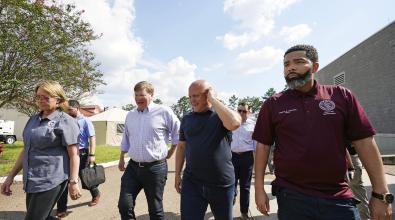 Read More
Read More
A new role for small cities thinking big about infrastructure

The trillions of dollars flowing to America’s cities and states as a result of the 2021 Bipartisan Infrastructure Law and other recent federal investments are doing more than help build new roads, water systems, broadband access, and climate resilience. They’re also prompting a growing number of small- and medium-sized cities to introduce a new role to their city halls: infrastructure coordinator.
The position is about more than pursuing the hundreds of new available grants—although that’s part of it. It’s also about helping cities think big about this unprecedented funding opportunity. “While many large cities have full teams dedicated to this work, small cities haven’t always had that capacity,” explains Ryan Whalen of Bloomberg Philanthropies, which, through its Local Infrastructure Hub, provides small- and medium-sized cities access to the resources their mayors say they need to overcome challenges to accessing and utilizing these federal funds. “Infrastructure coordinators are one of the innovative ways smaller cities are bridging that gap.”
Bloomberg Cities spoke with infrastructure coordinators in Albany, N.Y., and Bend, Ore., to learn more about how this new role can help mayors supercharge cross-city efforts to seek and access funding, implement new infrastructure projects, and take holistic approaches to problem solving.
Identifying and tapping once-in-a-generation grant opportunities
Cities looking to capitalize on the influx of federal infrastructure funding can, by adding focused capacity, turn important projects they thought they would get to “someday” into immediate and realistic priorities. In Albany and Bend, the new infrastructure coordinators have a citywide focus, which gives them ability to work across silos, align to the mayors’ overarching priorities, and then identify the most impactful grant opportunities.
In Bend, that means that Infrastructure Coordinator Sarah Hutson sits in the city manager’s office—rather than in a specific agency such as transportation or planning. This position provides her with a vantage point that allows her to consider the city’s needs holistically and tell its full story when applying for grants. “We try to be really thoughtful about where to pursue federal opportunities…and we have a list of considerations as to when it’s worthwhile to go after a grant,” she says.
Maintaining attention on long-term implementation while never losing sight of short-term priorities
In addition to thinking bigger about funding opportunities, infrastructure coordinators can play a critical role in keeping projects on track. Martin Daley, the infrastructure coordinator in Albany, compares his role to that of an orchestra conductor, keeping everyone playing together and in tune. He says the role also positions him to help ensure infrastructure projects, most of which require long-term focus and implementation, don’t get sidetracked by the drumbeat of everyday service delivery or emergencies.
Daley’s work in Albany includes partnering with the city’s recreation and engineering departments—both of which are responsible for a $20-million transformation of a 92-year-old Olympic-sized pool into a multi-purpose facility—to ensure momentum on the project even when their plates are packed with more immediate priorities around existing facilities and street maintenance. The city saw a real benefit in bringing an infrastructure coordinator in to both keep things moving and help the departments work together.
Empowering a holistic approach to problem spotting and solving
Because any city’s biggest problems—or best solutions, for that matter—aren’t confined to any one agency, one of the impactful benefits an infrastructure coordinator can bring to the table is spotting projects that might otherwise slip through the cracks of departmental boundaries. Plus, if positioned correctly, people in this role can offer a fresh perspective on new infrastructure projects—who they serve and what departments should be involved—that increase the cross-cutting impact of the work.
In Bend, this inter-department focus has given the city the space to think creatively about how to use infrastructure dollars to implement a $1-billion transportation plan that, when developed in 2020, they knew where only half of the funding would come from.
One of the fastest growing mid-sized cities in the world, Bend has rapidly expanded, leaving the city bifurcated by a highway and rail line. But by securing additional funds, and by facilitating collaboration between multiple departments, Bend is now eliminating at-grade crossings and moving forward with electric bike-sharing and climate resiliency plans. Accordingly, Infrastructure Coordinator Hutson is also working with multiple agencies to create a shared vision for an updated transportation plan and wildfire evacuation routes.
Altogether, this added capacity in cities—to access new funding, to implement projects, and to take holistic approaches to problem solving—is also opening city teams’ eyes to what’s possible. “It’s been energizing for us and there is a lot of excitement, Hutson says. “Had we not gotten this big infusion of federal dollars, I’m not sure if and when [the funding would have] happened.” Instead, she adds, the city has now leveled up its funding process, is competing for grants at a higher level, and is tackling infrastructure improvements that, only a few years ago, were beyond imagination.

